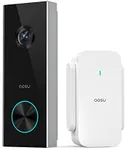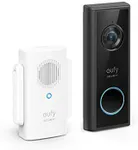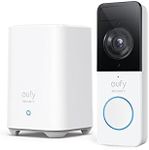Buying Guide for the Best Video Doorbell Without Subscription
Choosing a video doorbell without a subscription is a smart way to add security and convenience to your home without ongoing costs. The key is to focus on features that matter most to your daily life, such as video quality, storage options, connectivity, and ease of use. Think about where you’ll install the doorbell, how you want to access footage, and what kind of notifications or integrations you need. By understanding the main specifications, you can confidently select a doorbell that fits your needs and works well for your household.Video ResolutionVideo resolution refers to the clarity and detail of the footage your doorbell captures. Higher resolution means clearer images, which can help you recognize faces or details at your door. Common resolutions include 720p (HD), 1080p (Full HD), and 2K or higher. 720p is usually enough for basic monitoring, but 1080p offers a sharper picture and is a good middle ground for most users. If you want the best detail, especially for larger entryways or if you need to see further, 2K or higher is ideal. Choose based on how important image clarity is for your peace of mind and how much detail you want to capture.
Local Storage OptionsLocal storage means your video recordings are saved directly to a device at your home, such as a microSD card or a base station, instead of the cloud. This is crucial for avoiding subscription fees. Some doorbells have built-in slots for memory cards, while others use a separate hub. The size of the storage (measured in gigabytes) determines how many days of footage you can keep before it overwrites. If you want to review footage from several days ago, look for larger storage capacity. If you only need to check recent events, a smaller card will do. Make sure the doorbell supports easy access to the stored videos.
Field of ViewField of view describes how wide an area the camera can see, measured in degrees. A wider field of view lets you see more of your porch or entryway, which is helpful for spotting packages or visitors approaching from the side. Typical ranges are from 120° to 180°. If your door is in a narrow hallway, a smaller field of view is fine. For wide porches or if you want to see as much as possible, go for a higher number. Think about your entryway layout to decide what coverage you need.
Power SourceVideo doorbells can be powered by batteries, hardwired to your existing doorbell wiring, or sometimes both. Battery-powered models are easier to install and can go anywhere, but need recharging every few months. Hardwired models don’t need recharging but require existing wiring and a bit more installation effort. If you want a simple setup or don’t have wiring, battery is best. If you prefer not to worry about charging, and you have the wiring, hardwired is more convenient. Choose based on your home’s setup and your preference for maintenance.
Motion Detection and AlertsMotion detection allows the doorbell to alert you when someone approaches your door. Some models offer basic motion sensing, while others have advanced features like customizable zones or person detection. Basic motion detection is enough if you just want to know when anyone is at your door. If you want fewer false alerts (like from passing cars or animals), look for models with adjustable zones or smart detection. Think about how busy your entryway is and how specific you want your alerts to be.
Two-Way AudioTwo-way audio lets you speak with visitors through the doorbell using your phone or smart device. This is useful for talking to delivery people or guests when you’re not home. Most video doorbells offer this feature, but the quality can vary. If you plan to use this often, look for clear audio and minimal delay. If you rarely need to talk to visitors, basic audio will suffice.
App and Smart Home IntegrationThe app is how you view footage, get alerts, and control your doorbell. Some doorbells also work with smart home systems like Alexa or Google Assistant. A user-friendly app makes it easy to check your doorbell from anywhere. If you already use smart home devices, check for compatibility. If you just want simple notifications and video playback, a basic app is enough. Choose based on how connected you want your doorbell to be with your other devices.










